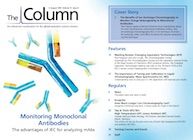Shimadzu Wins Two Red Dot Design Awards
Shimadzu has received two Red Dot Design Awards in the product design category for its new Nexera UHPLC series LC-40 and UV-1900 UV–vis spectrophotometer.
Shimadzu (Duisburg, Germany) has received two Red Dot Design Awards in the product design category for its new Nexera UHPLC series LC-40 and UV-1900 UV–vis spectrophotometer.
The Red Dot Design Awards are one of the three major design awards in the world with Shimadzu fending off competition to claim this year’s awards. Judged based on innovation, functionality, quality, ergonomics, and durability, more than 5500 products were submitted to the product design category by manufacturers and designers from 55 countries.
The award represents the third time in the company’s history that they have won a Red Dot Design Award, having previously picked up awards in 2013 and 2018.
The award ceremony was held in Essen, Germany, on 8 July 2019. An actual Nexera series instrument and an explanatory panel showing the UV-1900 will be displayed in the city’s Red Dot Museum for the next year.
For more information, please visit: www.shimadzu.eu/awards-of-shimadzu

Determining Enhanced Sensitivity to Odors due to Anxiety-Associated Chemosignals with GC
May 8th 2025Based on their hypothesis that smelling anxiety chemosignals can, like visual anxiety induction, lead to an increase in odor sensitivity, a joint study between the University of Erlangen-Nuremberg (Erlangen, Germany) and the Fraunhofer Institute for Process Engineering and Packaging (Freising, Germany) combined behavioral experiments, odor profile analysis by a trained panel, and instrumental analysis of odorants (gas chromatography-olfactometry) and volatiles (gas chromatography-mass spectrometry).
Investigating 3D-Printable Stationary Phases in Liquid Chromatography
May 7th 20253D printing technology has potential in chromatography, but a major challenge is developing materials with both high porosity and robust mechanical properties. Recently, scientists compared the separation performances of eight different 3D printable stationary phases.
Detecting Hyper-Fast Chromatographic Peaks Using Ion Mobility Spectrometry
May 6th 2025Ion mobility spectrometers can detect trace compounds quickly, though they can face various issues with detecting certain peaks. University of Hannover scientists created a new system for resolving hyper-fast gas chromatography (GC) peaks.

.png&w=3840&q=75)

.png&w=3840&q=75)



.png&w=3840&q=75)



.png&w=3840&q=75)










